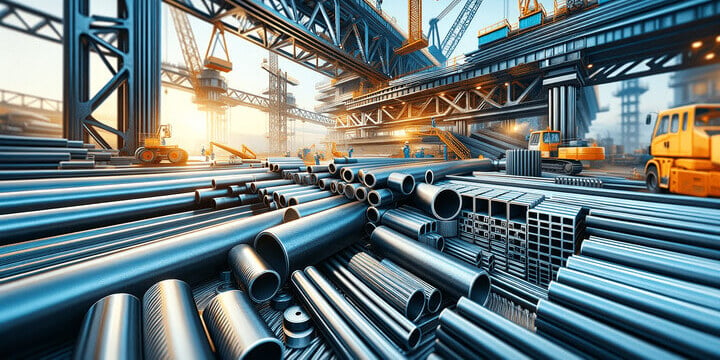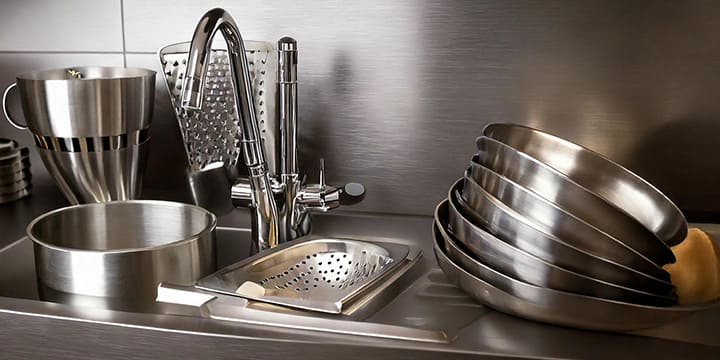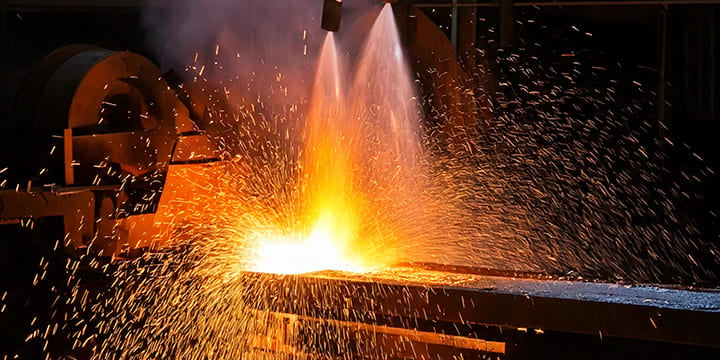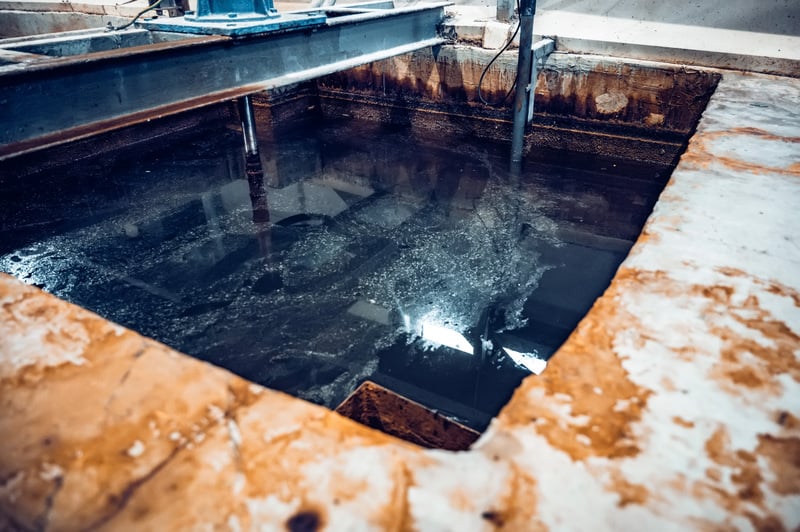Thép không gỉ có thực sự chống rỉ không? Thép không gỉ là gì?
Thép không gỉ, thường được sử dụng trong các ngành công nghiệp bán dẫn, màn hình LCD và điện tử chính xác, không hoàn toàn chống gỉ nhưng có khả năng chống ăn mòn cao. Xuất phát từ ngành công nghiệp thép, thép không gỉ được sản xuất từ sắt chiết xuất từ quặng sắt, với các nguyên tố hợp kim bổ sung như crom (Cr), niken (Ni), mangan (Mn), và molypden (Mo). Những nguyên tố này mang lại cho thép không gỉ khả năng chống ăn mòn và chống oxy hóa, khiến nó bền bỉ và dễ dàng làm sạch. Đây là lý do tại sao thép không gỉ là lựa chọn phổ biến cho các dụng cụ nhà bếp. Ngành công nghiệp bán dẫn đặc biệt yêu cầu nước siêu tinh khiết, sạch hơn 1000 lần so với nước máy, cho các quy trình tinh tế như làm sạch photomask, rửa wafer, khắc axit và đánh bóng cơ học. Việc chuẩn bị nước tinh khiết cho các quy trình này kết hợp nhiều kỹ thuật khác nhau, bao gồm chưng cất, nhựa trao đổi ion, thẩm thấu ngược (RO), điện thẩm tách, và lọc, để đảm bảo độ tinh khiết cao của nước.
Trong bối cảnh rộng hơn, thị trường thép không gỉ đang chứng kiến sự tăng trưởng, đặc biệt tại các khu vực Châu Á Thái Bình Dương như Trung Quốc, nhờ vào sự phát triển cơ sở hạ tầng và các tiến bộ công nghệ trong ngành thép. Các đặc tính của thép không gỉ, chẳng hạn như khả năng chống ăn mòn và độ bền, khiến nó phù hợp cho các ứng dụng trong xây dựng hiện đại, hệ thống xả ô tô và máy móc điện tử.
[1]
Thép AISI 303 và 306 là gì?
Chúng ta thường thấy các nhãn như "thép không gỉ 304 cấp thực phẩm" hoặc "thép không gỉ 316 cấp y tế" trên thị trường. Vậy các con số trước cụm từ "thép không gỉ" có ý nghĩa gì?
Thép không gỉ được gán các số khác nhau dựa trên thành phần kim loại và tỷ lệ hợp kim của nó. Thép không gỉ AISI 304 và 316 được đề cập ở trên là một phần của hệ thống đánh số do Viện Sắt và Thép Hoa Kỳ (AISI) phát triển và là những ký hiệu phổ biến cho các mục đích sử dụng chung.
Cr - Tạo một lớp bảo vệ oxit crom trên bề mặt kim loại, là yếu tố chính mang lại khả năng chống ăn mòn của thép không gỉ.
Ni - Tăng cường độ bền và độ dẻo của thép không gỉ, cải thiện khả năng chống ăn mòn trong môi trường có nồng độ ion hydro cao.
Mn - Tăng độ cứng và độ bền của thép, đồng thời cải thiện khả năng gia công và khả năng chống ăn mòn.
Mo - Tăng cường khả năng chống ăn mòn của thép không gỉ trong các môi trường khắc nghiệt, chẳng hạn như nước biển chứa ion clorua.
Việc đánh số các hợp kim thép không gỉ dựa trên tỷ lệ các nguyên tố hợp kim. Ví dụ, thép không gỉ AISI 304 chứa 18% crom và 8% niken (18-8), mang lại khả năng chống ăn mòn tuyệt vời và bề mặt sáng bóng. Loại này thường được sử dụng trong sản xuất đồ dùng nhà bếp và đồ nội thất.
Ngược lại, thép không gỉ AISI 316 chứa khoảng 16% crom, 10% niken (18-10), và 2% molypden, mang lại khả năng chống ăn mòn cao hơn so với 304, dù giá thành cao hơn. Ngoài đồ dùng nhà bếp, AISI 316 còn được sử dụng trong các cấu trúc hàng hải và linh kiện tàu thuyền nhờ khả năng chống nước muối vượt trội.
Thép không gỉ AISI 440 có độ cứng cao nhất nhưng khả năng chống ăn mòn kém hơn, phù hợp cho sản xuất dao kéo cao cấp và dụng cụ phẫu thuật.
Do đó, việc lựa chọn loại thép không gỉ phụ thuộc vào yêu cầu cụ thể như khả năng chống ăn mòn và độ cứng, thay vì chỉ dựa vào giá trị số cao hơn hoặc các phân biệt như cấp thực phẩm/cấp y tế.
Ngành công nghiệp thép
Thép không gỉ bắt nguồn từ ngành công nghiệp thép, một trụ cột của nhiều lĩnh vực như cơ sở hạ tầng, giao thông vận tải, sản xuất và cũng là một chỉ số kinh tế quan trọng. Ngành công nghiệp thép bao gồm nhiều lĩnh vực công nghiệp như nấu chảy, đúc, rèn, và cán.
Thép là một hợp kim chủ yếu bao gồm sắt, carbon, mangan, silic, v.v., nổi bật với độ bền cao, khả năng chống ăn mòn và tính dẻo. Dựa trên vật liệu, thép có thể được phân loại thành "thép carbon" và "thép không gỉ & thép hợp kim."
Đài Loan sản xuất khoảng 20 triệu tấn thép mỗi năm, xếp thứ 12 trên thế giới (Hiệp hội Thép Thế giới, 2022). Hiện tại, ngành công nghiệp thép đang hướng tới các cấu trúc vừa và nhỏ, sử dụng nhiều vốn và có tỷ lệ cao nhân viên kỹ thuật, biến nó thành một ngành công nghiệp đòi hỏi nhiều công nghệ.
Chuỗi cung ứng trong ngành công nghiệp thép
Trong ngành công nghiệp thép, sắt được phân thành hai loại chính dựa trên vật liệu của sản phẩm hoàn thiện: "Thép carbon" và "Thép không gỉ & Thép hợp kim." Hai loại này tiếp tục được chia thành các phân khúc thượng nguồn, trung nguồn và hạ nguồn dựa trên vai trò trong thị trường.
Thép carbon

Thượng nguồn: Nguyên liệu thô cho thép carbon bao gồm than đá, quặng sắt, khoáng sản cát và thép phế liệu. Các quy trình chính bao gồm luyện quặng trong lò cao (nung quặng sắt và khử để sản xuất sắt thô) hoặc tinh luyện trong lò hồ quang điện (EAF), cả hai đều tập trung vào việc tăng cường độ bền và độ cứng của thép. Các sản phẩm bao gồm phôi vuông, phôi thỏi và phôi tấm. Hàm lượng carbon là yếu tố phân biệt thép carbon với thép không gỉ, không có các nguyên tố chống ăn mòn như crom.
Trung nguồn: Bao gồm các quy trình khác nhau như cán nóng/lạnh để sản xuất thép tấm, thép cây, cuộn thép, cuộn dây thép và nhiều loại khác. Ngoài ra còn có các loại thép hình và thép góc được sản xuất thông qua các quy trình cán, cắt, xén và gia công.
Hạ nguồn:
1. Ngành Xây Dựng: Thép tấm cán nóng và cán nguội cùng với thép cây được sử dụng trong xây dựng các công trình, cầu, đường và các cơ sở hạ tầng khác.
2. Sản Xuất Máy Móc: Cuộn thép và cuộn dây thép được ứng dụng rộng rãi trong sản xuất thiết bị máy móc, linh kiện xe cộ và các loại máy móc công nghiệp khác.
3. Chế Biến và Sản Xuất: Thép sau khi được cắt và gia công sẽ tạo thành các loại thép hình, thép góc, được sử dụng để sản xuất linh kiện, lắp ráp, thủ công mỹ nghệ và nhiều sản phẩm khác.
4. Năng Lượng và Vận Tải: Thép được sử dụng rộng rãi trong các lĩnh vực sản xuất năng lượng và vận tải, bao gồm thanh thép, đường ống và nhiều ứng dụng khác.
Thép không gỉ & Thép hợp kim

Thượng nguồn: Nguyên liệu thô cho thép không gỉ bao gồm quặng sắt, crom, niken, coban, v.v. Quặng sắt, một loại quặng tự nhiên chứa sắt, chủ yếu bao gồm oxit sắt, cacbonat và sunfat. Trong sản xuất thép không gỉ, sắt được chiết xuất từ quặng sắt thông qua quy trình lò điện. Niken, molypden, đồng, titan, niobi và các nguyên tố hợp kim khác được thêm vào để tạo ra thép không gỉ, mang lại khả năng chống ăn mòn và chống oxy hóa.
Trung nguồn: Do các yêu cầu cụ thể (chống ăn mòn, ứng dụng cấp thực phẩm, v.v.), giai đoạn này có thể bao gồm các quy trình bổ sung như cắt, sản xuất ống (đùn, kéo, uốn, v.v.), xử lý bề mặt (đánh bóng, tẩy rửa, mạ crom, v.v.), hàn và kết nối (hàn TIG, hàn laser, v.v.).
Hạ nguồn:
1. Chế Biến Thực Phẩm và Ẩm Thực: Các dụng cụ thép không gỉ có khả năng chống ăn mòn cao được sử dụng rộng rãi trong sản xuất thực phẩm và ẩm thực, bao gồm khay, bát và dụng cụ ăn bằng thép không gỉ.
2. Dụng Cụ Y Tế: Khả năng chống ăn mòn và tương thích sinh học của thép không gỉ khiến nó trở thành vật liệu ưa thích để sản xuất dụng cụ phẫu thuật và thiết bị y tế.
3. Công Nghệ Hóa Chất và Kỹ Thuật Hàng Hải: Ống và thùng chứa bằng thép không gỉ rất phổ biến trong ngành hóa chất và kỹ thuật hàng hải nhờ khả năng chống ăn mòn trong môi trường khắc nghiệt.
4. Gia Dụng và Trang Trí: Khả năng chịu nhiệt độ cao, dễ làm sạch, độ bền và thân thiện với môi trường của thép không gỉ khiến nó được ưa chuộng trong sản xuất đồ nội thất, như đèn và dụng cụ nhà bếp.
[2]
Hỗ trợ quan trọng trong quy trình sản xuất thép - Đầu phun và lưu lượng kế
Ứng dụng 1: Sử dụng đầu phun trong ngành công nghiệp thép
Đầu phun đóng vai trò là công cụ quan trọng trong ngành công nghiệp thép, không chỉ làm mát phôi thép mà còn kiểm soát chính xác lưu lượng chất làm mát trong quá trình luyện thép, đảm bảo phân phối đồng đều các nguyên tố hợp kim.
Trong hoạt động lò cao, đầu phun tối ưu hóa việc sử dụng năng lượng nhiệt, nâng cao hiệu quả sản xuất. Ngoài ra, đầu phun còn được ứng dụng rộng rãi trong các quy trình xử lý bề mặt thép như làm sạch tấm, phủ lớp bảo vệ và chống ăn mòn, đảm bảo chất lượng sản phẩm vượt trội và tính toàn vẹn của bề mặt.

Trường hợp: Nhà sản xuất thép thanh tại Đài Loan với sản lượng 600.000 tấn mỗi năm Tình hình
Công ty sử dụng công nghệ lò hồ quang điện để sản xuất thép thanh, yêu cầu sử dụng các thanh điện cực graphite để dẫn điện, tạo ra lò luyện thép ở nhiệt độ cao. Sau khi các thanh điện cực hoàn thành nhiệm vụ, nước làm mát được phun qua các đầu phun để giảm nhiệt độ.
Ban đầu, công ty sử dụng đầu phun bằng đồng để làm mát, nhưng đồng dễ bị biến dạng trong điều kiện nhiệt độ cao, dẫn đến tuổi thọ đầu phun ngắn và phải thay thế thường xuyên, làm tăng chi phí vận hành.
Giải pháp: LORRIC - Vòi Phun Hình Nón Đặc KG Dành Cho Ngành Công Nghiệp Thép
LORRIC đề xuất chuyển sang sử dụng vòi phun bằng thép không gỉ để kéo dài tuổi thọ sản phẩm. Vòi phun hình nón đặc KG chuyên dụng của LORRIC dành cho ngành công nghiệp thép có thiết kế tấm tạo xoáy dạng chữ X, giảm sự hỗn loạn của chất lỏng để đảm bảo các hạt phun đồng đều, qua đó nâng cao hiệu quả làm mát. Vật liệu thép không gỉ của vòi phun LORRIC đảm bảo tuổi thọ dài hơn so với các vòi phun thông thường. Công ty đã xác nhận hiệu quả phun của vòi qua thử nghiệm thực tế, dẫn đến quyết định chọn vòi KG làm đầu phun chuyên dụng cho thiết bị làm mát thanh điện cực.

Trường hợp: Nhà sản xuất hàng đầu tại khu vực Đại Trung Hoa về ngành công nghiệp dây cáp và thép đặc biệt
Tình hình:
Thành lập tại Đài Loan vào năm 1966, công ty ban đầu tập trung vào sản xuất dây và cáp. Ngày nay, công ty đã trở thành một trong những nhà sản xuất hàng đầu trong ngành dây cáp và thép đặc biệt tại khu vực Đại Trung Hoa. Trong lĩnh vực kinh doanh cốt lõi, mảng dây cáp bao gồm các sản phẩm từ vật liệu đồng, dây cáp điện và dây cáp truyền thông. Trong khi đó, mảng thép không gỉ sản xuất phôi thép không gỉ, thép cuộn, thanh cán nguội, ống thép không mối nối, trở thành nhà sản xuất hàng đầu về các sản phẩm thép không gỉ dài tại châu Á.
Công ty đối mặt với thách thức trong quy trình tẩy gỉ, nơi họ sử dụng các đầu phun từ các thương hiệu châu Âu và Mỹ. Dung dịch tẩy gỉ trong quy trình chứa các chất ăn mòn mạnh như axit nitric (HNO₃) và axit hydrofluoric (HF), gây ra tình trạng tắc nghẽn đầu phun. Kết quả là thiết bị phải ngừng hoạt động hai tháng một lần để bảo trì và thay thế đầu phun. Chi phí cao của các đầu phun từ các thương hiệu châu Âu và Mỹ đã làm tăng chi phí bảo trì, buộc công ty phải tìm kiếm một giải pháp thay thế phù hợp.
Giải pháp: LORRIC - Vòi Phun Dạng Quạt KAD Nhiều Bộ Phận
Sau khi tìm hiểu yêu cầu của khách hàng, chúng tôi đã đề xuất vòi phun dạng quạt nhiều bộ phận KAD. Vòi phun KAD sử dụng thiết kế ba bộ phận, giúp dễ dàng bảo trì, vệ sinh và thay thế. Thiết kế định vị độc đáo giữa vòi và đế đảm bảo rằng mỗi lần thay thế đều duy trì được vị trí ban đầu. Ngay cả khi thay thế thường xuyên, hiệu suất tổng thể của dây chuyền sản xuất cũng không bị ảnh hưởng.
Ứng dụng 2: Ứng dụng của lưu lượng kế trong ngành công nghiệp thép
Lưu lượng kế là một công cụ kỹ thuật quan trọng trong ngành công nghiệp thép. Trong quá trình luyện sắt bằng lò cao, lưu lượng kế được sử dụng rộng rãi để giám sát dòng chảy của nước làm mát, nhiên liệu và chất làm mát, đảm bảo sự ổn định của hệ thống và tối ưu hóa việc sử dụng năng lượng cũng như tài nguyên.
Hơn nữa, lưu lượng kế còn được áp dụng ở các giai đoạn như xử lý nhiệt, đúc liên tục và cán, giúp kiểm soát chính xác tốc độ làm mát và các thông số quy trình, đạt được sự điều chỉnh thép chính xác.
Trong lĩnh vực xử lý bề mặt thép, việc ứng dụng lưu lượng kế đảm bảo tỷ lệ chất lỏng chính xác trong các quy trình như phủ, chống ăn mòn và làm sạch, từ đó bảo đảm chất lượng sản phẩm và hiệu quả chi phí.

Trường hợp: Nhà sản xuất thép không gỉ hàng đầu tại Đài Loan
Tình hình:
Công ty này là nhà máy thép không gỉ tích hợp theo chiều dọc đầu tiên tại Đài Loan, với quy trình hoàn chỉnh bao gồm nấu chảy, cán nóng và cán nguội. Các sản phẩm thép không gỉ của họ không chỉ đáp ứng nhu cầu thị trường nội địa mà còn được xuất khẩu sang nhiều quốc gia ở châu Á, châu Phi, châu Âu và châu Mỹ. Các sản phẩm đã qua chế biến được ứng dụng rộng rãi trong ngành công nghiệp ô tô, đồ gia dụng, sản xuất máy móc và xây dựng.
Công ty muốn lắp đặt lưu lượng kế trên các ống thép không gỉ kích thước 1-½" để phát hiện tắc nghẽn mà không gây nguy cơ rò rỉ do việc cắt ống. Họ đã tìm kiếm lời khuyên từ công ty chúng tôi để tìm ra giải pháp phù hợp.
Giải pháp: LORRIC FU-TX310 Đồng Hồ Đo Lưu Lượng Siêu Âm Kẹp
Xem xét môi trường làm việc của khách hàng, LORRIC đã đề xuất sử dụng đồng hồ đo lưu lượng siêu âm kẹp FU-TX310. FU-TX310 của LORRIC có thiết kế lắp đặt bên ngoài, cho phép khách hàng lắp đặt và bắt đầu giám sát lưu lượng mà không cần ngừng hoạt động của thiết bị. Đặc điểm không xâm lấn, không cần cắt ống giúp đồng hồ đo lưu lượng dễ dàng lắp đặt, tháo gỡ, bảo trì hoặc hiệu chuẩn, giảm đáng kể chi phí bảo trì. Trong quá trình lắp đặt đồng hồ đo lưu lượng siêu âm, việc đặt đầu dò không đúng cách có thể ảnh hưởng đến độ chính xác của dữ liệu. Để giải quyết khó khăn này, LORRIC đã phát triển các chốt định vị đầu dò được cấp bằng sáng chế. Những chốt này giúp khách hàng dễ dàng xác định vị trí đúng của đầu dò, đơn giản hóa quy trình lắp đặt. Sau khi thử nghiệm đồng hồ đo lưu lượng siêu âm kẹp FU-TX310, công ty rất hài lòng với độ chính xác của sản phẩm. Thiết kế lắp đặt bên ngoài loại bỏ hoàn toàn lo ngại về nguy cơ rò rỉ và mất áp suất do cắt ống, đáp ứng hoàn hảo nhu cầu của họ.